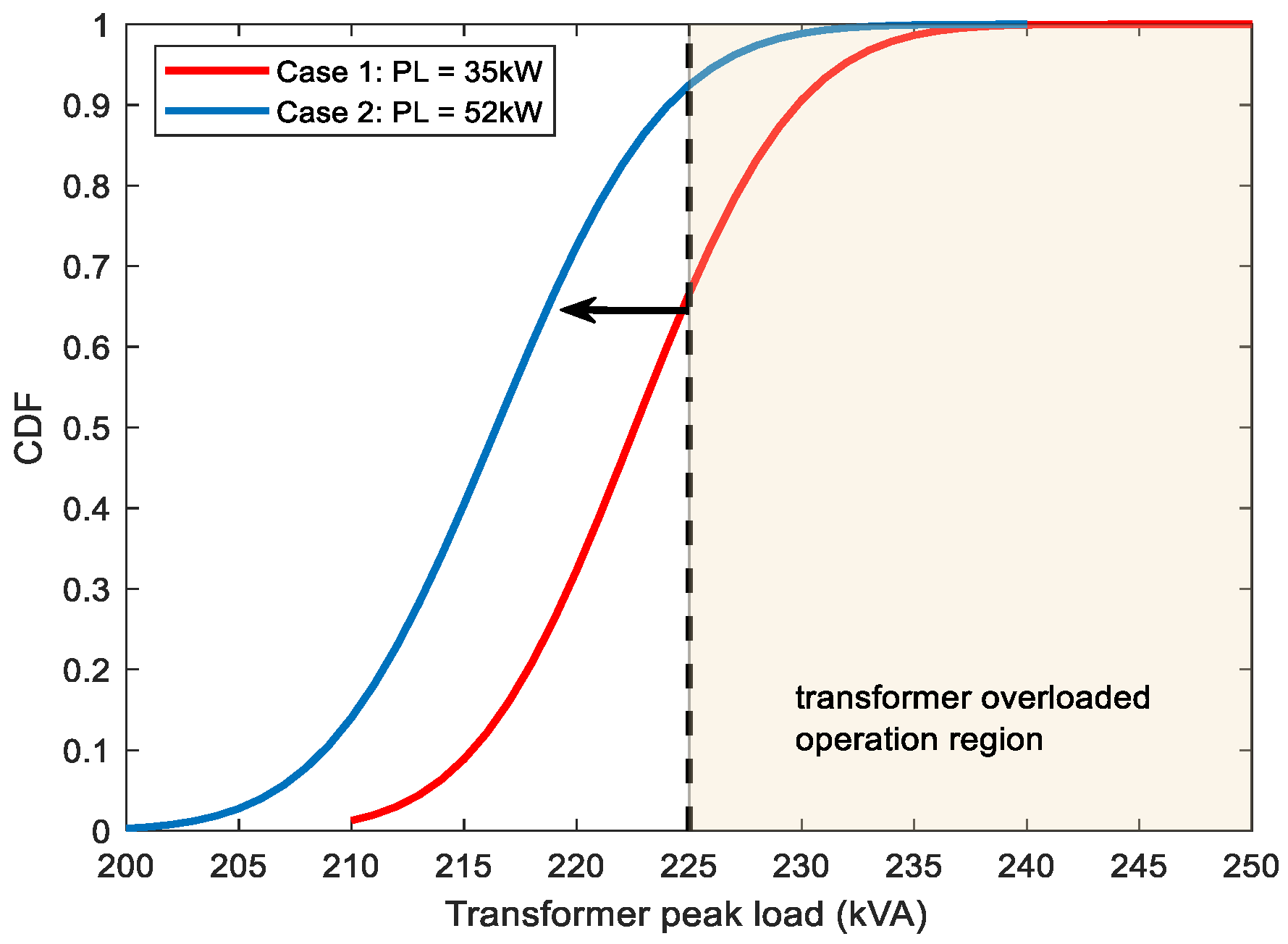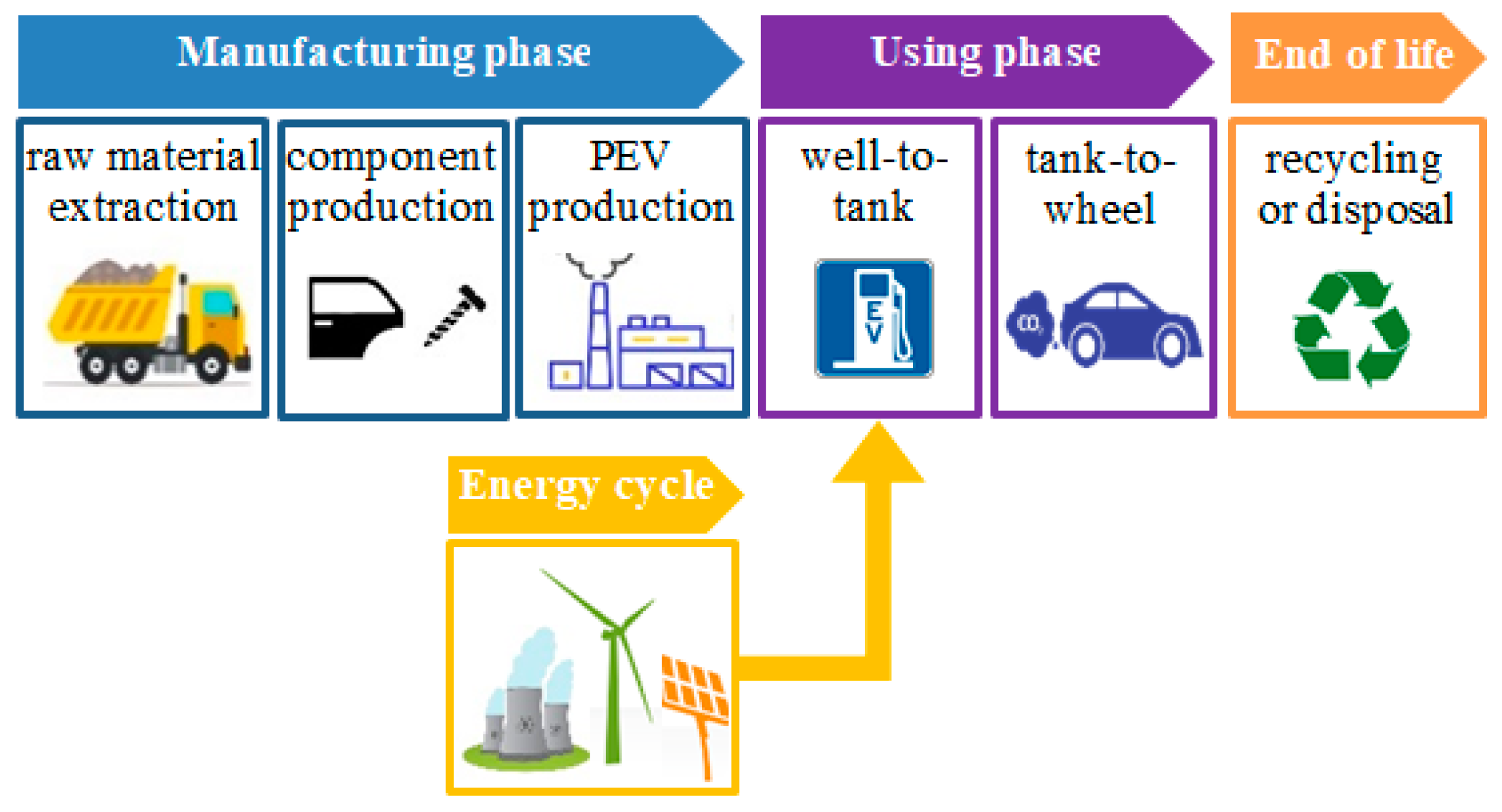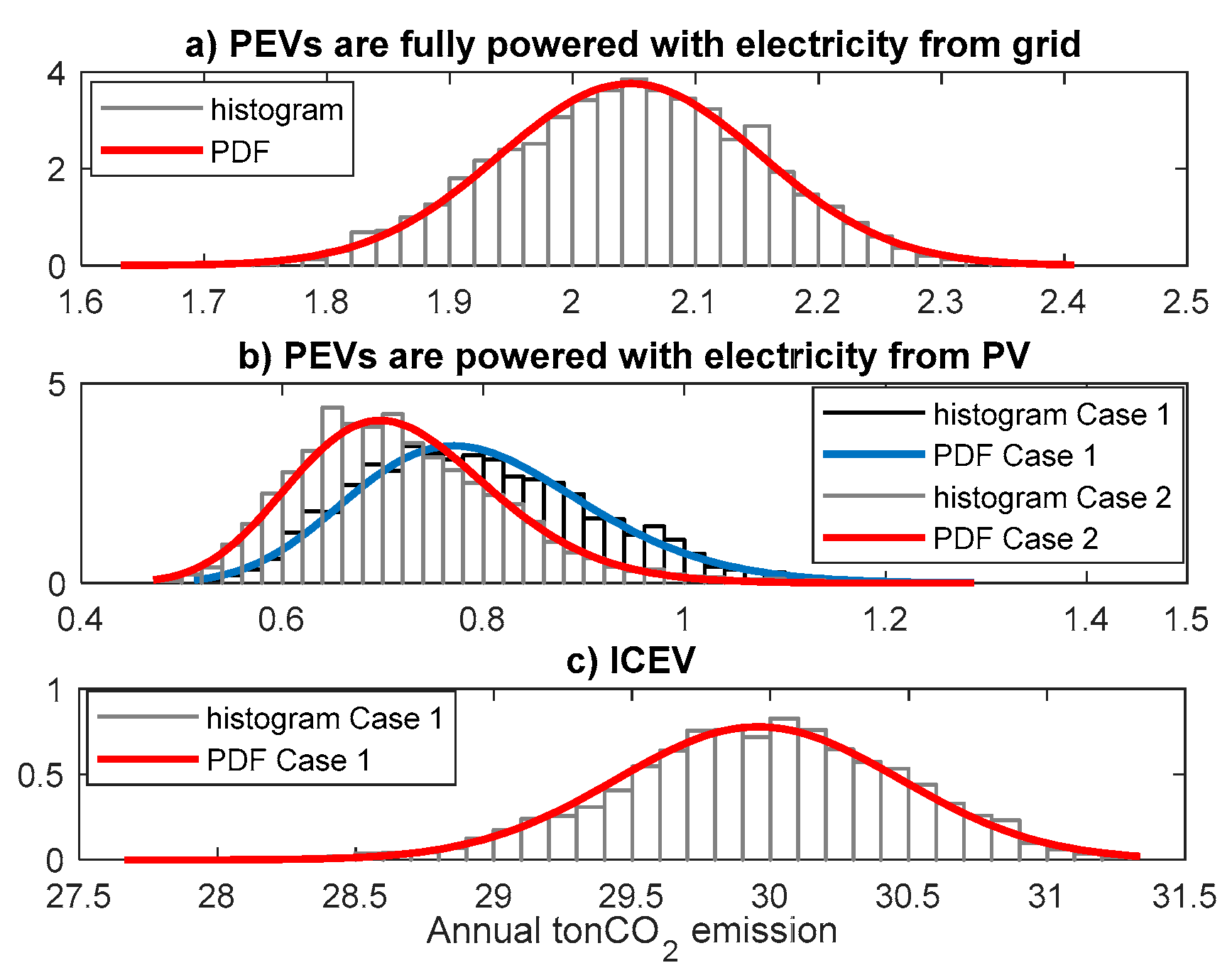Probabilistic Approach to Integrate Photovoltaic Generation into PEVs Charging Stations Considering Technical, Economic and Environmental Aspects
Abstract
:1. Introduction
- The study is based on real data collected with an advanced metering infrastructure system installed in a University Campus located in the Amazon region, in northern Brazil;
- Unlike other studies, PEVs demand is represented individually instead of aggregated, considering important parameters to each vehicle, such as arriving time and battery initial state-of-charge;
- Uncertainties due to solar generation, PEVs and building demand are considered in the model in a stochastic manner, using Monte Carlo simulation;
- The analysis simultaneously incorporates technical, economic and environmental issues allowing a global view of the problem to power systems planning purpose, showing the benefits of using green technologies;
- Power system is modeled and considered in simulations through power flow analysis.
2. Case Study: Building Demand Data
3. Probabilistic Modeling
3.1. Building Electricity Demand
3.2. Electrical Vehicle Demand
3.3. Photovoltaic Generation
4. Simulation Results
4.1. Technical Analysis
4.1.1. PEV Charging Stations
4.1.2. PEV Charging Stations with PV Generation
- Case 1: PL = 15.63% (35.17 kW);
- Case 2: PL = 23.52% (52.93 kW).
4.2. Economic Analysis
4.3. Environmental Analysis
5. Conclusions
- Even though distribution transformer has currently a low utilization factor of only 55% of its rated capacity, the connection of four Level 2 charging stations in the building parking lot will result in overloaded operation with a probability of occurrence of 77.9% in a future scenario of 9 years-ahead. This probability increases to 100% in year 10;
- The installation of a PV generation system with penetration level of 15.6% can reduce transformer overloading probability from 100% to 31.2%, and almost eliminate violations reducing overloading probability to 8.2% when a penetration level of 23.5% is adopted. The overload duration is also reduced, from an average value of 4 h to 1 h;
- A substantial reduction of 93.2% tonCO2 is obtained when PEVs are fully powered with electricity from grid, and 97.4% tonCO2 when PEVs are powered with electricity from PV generation;
- In both photovoltaic systems projects (PL = 15.6% and 23.5%), NPV is always positive and IRR is greater than the minimum required rate of return of 7%, with payback periods varying from 6 years to 11 years, which confirms both projects are economically robust and attractive.
Author Contributions
Funding
Acknowledgments
Conflicts of Interest
References
- International Energy Agency. Tracking Transport 2020. Available online: https://www.iea.org/reports/tracking-transport-2020 (accessed on 18 August 2020).
- International Energy Agency. Global EV Outlook 2020. Available online: https://www.iea.org/reports/global-ev-outlook-2020 (accessed on 18 August 2020).
- REN21. Available online: https://www.ren21.net/wp-content/uploads/2019/05/gsr_2020_full_report_en.pdf (accessed on 18 August 2020).
- Kikhavani, M.R.; Hajizadeh, A.; Shahirinia, A. Charging coordination and load balancing of plugin electric vehicles in unbalanced low-voltage distribution systems. IET Gener. Transm. Distrib. 2020, 14, 389–399. [Google Scholar] [CrossRef]
- Colmenar-Santos, A.; Mena, A.R.L.; Diez, D.B.; Alemany, C.D.Q. Impact assessment of electric vehicles on islands grids: A case study for Tenerife (Spain). Energy 2017, 120, 385–396. [Google Scholar] [CrossRef]
- Affonso, C.M.; Kezunovic, M. Technical and Economic Impact of PV-BESS Charging Station on Transformer Life: A Case Study. IEEE Trans. Smart Grid 2018, 10, 4683–4692. [Google Scholar] [CrossRef]
- Stellios, I.; Kotzanikolaou, P.; Psarakis, M.; Alcaraz, C.; Lopez, J. A Survey of IoT-Enabled Cyberattacks: Assessing Attack Paths to Critical Infrastructures and Services. IEEE Communic. Surv. Tutor. 2018, 20, 3453–3495. [Google Scholar] [CrossRef]
- Jafari, M.; Gauchia, A.; Zhao, S.; Zhang, K.; Gauchia, L. Electric Vehicle Battery Cycle Aging Evaluation in Real-World Daily Driving and Vehicle-to-Grid Services. IEEE Trans. Transp. Electrif. 2018, 4, 122–134. [Google Scholar] [CrossRef]
- Turan, M.T.; Ates, Y.; Erdinc, O.; Gokalp, E.; Catalão, J.P.S. Effect of electric vehicle parking lots equipped with roof mounted photovoltaic panels on the distribution network. Electr. Power Energy Syst. 2019, 109, 283–289. [Google Scholar] [CrossRef]
- Abdullah, H.M.; Kamel, R.M.; Tahir, A.; Sleit, A.; Gastli, A. The Simultaneous Impact of EV Charging and PV Inverter Reactive Power on the Hosting Distribution System’s Performance: A Case Study in Kuwait. Energies 2020, 13, 4409. [Google Scholar] [CrossRef]
- Domínguez-Navarro, J.A.; Dufo-López, R.; Yusta-Loyo, J.M.; Artal-Sevil, J.S.; Bernal-Agustín, J.L. Design of an electric vehicle fast-charging station with integration of renewable energy and storage systems. Electr. Power Energy Syst. 2019, 105, 46–58. [Google Scholar] [CrossRef]
- Eseye, A.T.; Lehtonen, M.; Tukia, T.; Uimonen, S.; Millar, R.J. Optimal Energy Trading for Renewable Energy Integrated Building Microgrids Containing Electric Vehicles and Energy Storage Batteries. IEEE Access 2019, 7, 106092–106101. [Google Scholar] [CrossRef]
- Tucki, K.; Orynycz, O.; Mitoraj-Wojtanek, M. Perspectives for Mitigation of CO2 Emission due to Development of Electromobility in Several Countries. Energies 2020, 13, 4127. [Google Scholar] [CrossRef]
- Ministério de Minas e Energia. National Energy Balance 2020; EPE: Rio de Janeiro, Brazil, 2020; pp. 1–73. (In Portuguese)
- Monteiro, F.P.; Monteiro, S.A.; Tostes, M.E.; Bezerra, U.H. Using True RMS Current Measurements to Estimate Harmonic Impacts of Multiple Nonlinear Loads in Electric Distribution Grids. Energies 2019, 12, 4132. [Google Scholar] [CrossRef]
- Rubistein, R.Y. Simulation and the Monte Carlo Method; John Wiley & Sons Inc.: Hoboken, NJ, USA, 1981. [Google Scholar]
- MATLAB User’s Guide. Available online: https://www.mathworks.com/ (accessed on 4 May 2018).
- PSAT Software. Available online: http://faraday1.ucd.ie/psat.html (accessed on 27 May 2018).
- Ding, M.; Wu, X. Three-phase Probabilistic Load Flow Including Photovoltaic Generation in Distribution System. Int. J. Autom. Power Eng. 2012, 1, 151–158. [Google Scholar]
- Keyhani, A.; Marwali, M. Smart Power Grids 2011; Springer: Berlin/Heidelberg, Germany, 2011. [Google Scholar]
- Dai, Q.; Liu, J.; Wei, Q. Optimal Photovoltaic/Battery Energy Storage/Electric Vehicle Charging Station Design Based on Multi-Agent Particle Swarm Optimization Algorithm. Sustainability 2019, 11, 1973. [Google Scholar] [CrossRef] [Green Version]
- Ul-Haq, A.; Cecati, C.; El-Saadany, E. Probabilistic modeling of electric vehicle charging pattern in a residential distribution network. Electric Power Syst. Res. 2018, 157, 126–133. [Google Scholar] [CrossRef]
- Franco, F.L.; Ricco, M.; Mandrioli, R.; Grandi, G. Electric Vehicle Aggregate Power Flow Prediction and Smart Charging System for Distributed Renewable Energy Self-Consumption Optimization. Energies 2020, 13, 5003. [Google Scholar] [CrossRef]
- SAE Electric Vehicle and Plug-In Hybrid Electric Vehicle Conductive Charge Coupler; SAE Standard J1772; SAE: Warrendale, PA, USA, 2010.
- Muratori, M. Impact of uncoordinated plug-in electric vehicle charging on residential power demand. Nat. Energy 2018, 3, 193–201. [Google Scholar] [CrossRef]
- Nissan Motor Corporation. Available online: https://www.nissancdn.net/content/dam/Nissan/pt/brochures/E-Catalago_LEAF-2018_PT.pdf (accessed on 20 February 2019).
- Chevrolet Division of General Motors Company. Available online: https://www.chevrolet.com.br/eletrico/bolt-ev (accessed on 20 February 2019).
- National Renewable Energy Laboratory—NREL. Available online: http://pvwatts.nrel.gov/ (accessed on 3 April 2019).
- Karmaker, A.K.; Ahmed, M.R.; Hossain, M.A.; Sikder, M.M. Feasibility Assessment & Design of Hybrid Renewable Energy Based Electric Vehicle Charging Station in Bangladesh. Sustain. Cities Soc. 2018, 39, 189–202. [Google Scholar]
- CRESESB. Available online: https://cresesb.cepel.br (accessed on 22 February 2019).
- BYD. Available online: http://www.byd.ind.br/produtos/solar/ (accessed on 16 June 2019).
- Fronius. Available online: https://www.fronius.com/pt-br/brasil (accessed on 16 June 2019).
- German Solar Energy Society. Planning and Installing Photovoltaic Systems: A Guide for Installers, Architects and Engineers, 3rd ed.; Routledge: New York, NY, USA, 2017. [Google Scholar]
- Mohanty, M.; Kelapure, S. Aggregated rooftop PV sizing in distribution feeder considering harmonic distortion limit. In Proceedings of the IEEE National Power Systems Conference (NPSC), Bhubaneswar, India, 19–21 December 2016. [Google Scholar]
- Weygandt, J.J.; Kimmel, P.D.; Kieso, D.E. Accounting Principles; John Wiley & Sons: Hoboken, NJ, USA, 2018. [Google Scholar]
- Exame Magazine. Available online: https://exame.abril.com.br/pme/como-calcular-o-custo-do-capitalproprio-no-seu-negocio/ (accessed on 29 April 2020).
- Aldo Solar. Available online: https://www.aldo.com.br/loja/marcas/ (accessed on 29 April 2020).
- SOLARVOLT. Available online: https://www.solarvoltenergia.com.br/blog/kit-de-energia-solar-vidautil (accessed on 29 April 2020).
- Ismael, E.A.; Hashim, S.M. An Economic Evaluation of Grid Connected Photovoltaic System for a Residential House in Khartoum. In Proceedings of the International Conference on Computer, Control, Electrical, and Electronics Engineering (ICCCEEE), Khartoum, Sudan, 12–14 August 2018. [Google Scholar]
- Banco Central do Brasil. Inflation Report; Banco Central do Brasil: Brasília, Brazil, 2019; Volume 21, pp. 1–59. (In Portuguese)
- Operador Nacional do Sistema Elétrico. Available online: http://www.ons.org.br/ (accessed on 4 July 2020).
- Ministério da Ciência, Tecnologia e Inovações. Available online: http://www.mctic.gov.br/ (accessed on 4 July 2020).
- Electricity Info. Available online: http://electricityinfo.org/realtime-british-electricity-supply/ (accessed on 4 July 2020).
- Fthenakis, V.; Raugei, M. Environmental life-cycle assessment of photovoltaic systems. In The Performance of Photovoltaic (PV) Systems: Modelling, Measurement and Assessment; Elsevier: Cambridge, UK, 2017; pp. 209–232. [Google Scholar]
- Edwards, R.; Larivé, J.-F.; Beziat, J.-C. Well-to-Wheels Analysis of Future Automotive Fuels and Power Trains in the European Context, 3rd ed.; Publications Office of the European Union: Luxembourg, 2011. [Google Scholar]


















| Vehicle Battery Specification | Nissan Leaf | Chevrolet Bolt |
|---|---|---|
| Battery Energy (E) | 0.1058 kWh/km | 0.1567 kWh/km |
| Battery Capacity (Cb) | 40 kWh | 60 kWh |
| PV Module | |
|---|---|
| Peak Power | 335 W |
| Rated voltage Vmp | 37.35 V |
| Rated current Imp | 8.97 A |
| Open circuit voltage Voc | 47.28 V |
| Short circuit current Isc | 9.39 A |
| Efficiency | 17.4% |
| Dimension | 1.95 m × 0.98 m |
| Inverter | |
| Maximum PV power | 37.8 kW |
| Nominal power | 27 kW |
| MPPT voltage range | 580–850 V |
| DC input voltage range | 580–1000 V |
| Number of Hours Transformer Operates Overloaded | |||
|---|---|---|---|
| PV Level | 1 h | 2 h | 3 h |
| PL = 15.6% | 88.5% | 11.1% | 0.4% |
| PL = 23.5% | 97.2% | 2.8% | 0% |
| Equipment costs (PL = 15.6%) | R$ 141,993.24 |
| Equipment costs (PL = 23.5%) | R$ 217,359.67 |
| O&M costs | 1%/year |
| Inflation rate | 5%/year |
| Energy price increase rate | 8%/year |
| Panel degradation rate | 0.8%/year |
| TOU Rate (peak hours 19 h–22 h) | 2.63 R$/kWh |
| TOU Rate (off-peak hours) | 0.31 R$/kWh |
| PLPV = 15.6% | PLPV = 23.5% | |
|---|---|---|
| Minimum | 6 years | 8 years |
| Mean | 7 years | 9 years |
| Max. | 8 years | 11 years |
© 2020 by the authors. Licensee MDPI, Basel, Switzerland. This article is an open access article distributed under the terms and conditions of the Creative Commons Attribution (CC BY) license (http://creativecommons.org/licenses/by/4.0/).
Share and Cite
Branco, N.C.; Affonso, C.M. Probabilistic Approach to Integrate Photovoltaic Generation into PEVs Charging Stations Considering Technical, Economic and Environmental Aspects. Energies 2020, 13, 5086. https://doi.org/10.3390/en13195086
Branco NC, Affonso CM. Probabilistic Approach to Integrate Photovoltaic Generation into PEVs Charging Stations Considering Technical, Economic and Environmental Aspects. Energies. 2020; 13(19):5086. https://doi.org/10.3390/en13195086
Chicago/Turabian StyleBranco, Najmat Celene, and Carolina M. Affonso. 2020. "Probabilistic Approach to Integrate Photovoltaic Generation into PEVs Charging Stations Considering Technical, Economic and Environmental Aspects" Energies 13, no. 19: 5086. https://doi.org/10.3390/en13195086






